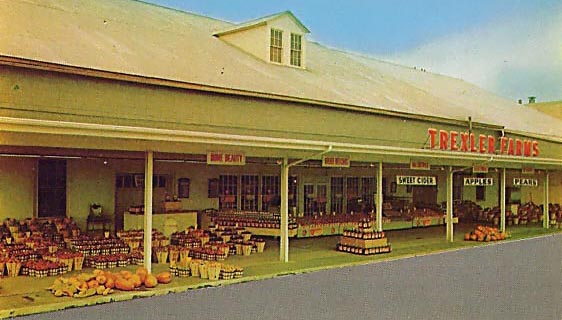
Pennsylvania Fruit and Vegetable Stand
Fruit Orchard and Vegetable Garden Stand outside of Allentown

| Allentown
is a city located in Lehigh County, Pennsylvania. As of the 2000 census,
the city had a total population of 106,632. It is the county seat of
Lehigh County . Allentown was founded in 1762 by William Allen, who
originally called it Northamptontown. In 1838, the town was named after
him. The city also is known for a famous Billy Joel song,
"Allentown," which appeared on Joel's "The Nylon
Curtain" (1982) and "Greatest Hits: Volume II" (1985)
albums. The song depicts the resolve of Allentownians, amidst the rough
and hardened life that characterizes this East Coast, industrial city. The
city is served by Lehigh Valley International Airport, which also serves
Bethlehem, Pennsylvania.
Allentown was originally named Northamptontown by its founder, Chief Justice of Colonial Pennsylvania's Supreme Court, William Allen. Allen, also a former Mayor of Philadelphia and successful businessman, drew up plans for the rural village in 1762. Despite its formal name, from the beginning, nearly everyone called it "Allen's town". Allen hoped Northamptontown would turn into a commercial center because of its location along the Lehigh River. The low water level most of the year, however, made river trade impractical. Sometime in the early 1770s, William Allen apparently gave the property to his son, James, who built a country home called Trout Hall after his father's hunting and fishing lodge. Even by the time of the American Revolution, Allentown remained little more than a small village of Pennsylvania Dutch, more properly German, farmers and tradesmen, but continued its development as a center of marketing for local farmers from the post revolutionary years into the 1920s. The U.S. Census of 1810 placed it at the heart of the largest grain producing regions in the country. In 1838, the city officially adopted the name Allentown which was not the only change in store for this town on the Lehigh. By the 1830s and 1840s, America's industrial revolution, which was born in the Lehigh Valley, was entering its take-off stage, and the arrival of the Lehigh Canal and later the railroad, opened up Allentown in a way that would have been beyond William Allen's wildest dreams. The 1850s and 1860s saw the rise of a strong local iron industry. The nation's growing railroad network soaked up all the iron Allentown could produce. By the post Civil War era, a large influx of German and Irish workers had created a mini-Pittsburgh along the banks of the Lehigh. But all of this prosperity fell apart with the collapse of the railroad boom in the Panic of 1873. Big and small iron furnaces closed one by one and sent the industry into a tail-spin from which it never recovered. By the dawn of the 20th century, the community had fully recovered from the economic disasters of the 19th century. Silk mills had taken over from the dying iron trade, but they were not alone. Allentown's diverse economy produced everything from parlor furniture to beer and cigars. Since World War II and particularly since the 1960s, Allentown has undergone yet another transition. Faced with the decline of manufacturing and the rise of the service economy, the city is once again dealing with change. City officials are currently trying to attract business to the downtown district, primarily as a way to find new uses for existing structures. The City's infrastructure offers state-the-art technology, including a fiber optic loop and uninterrupted electrical service, which plays a role in attracting businesses to the downtown district. |
